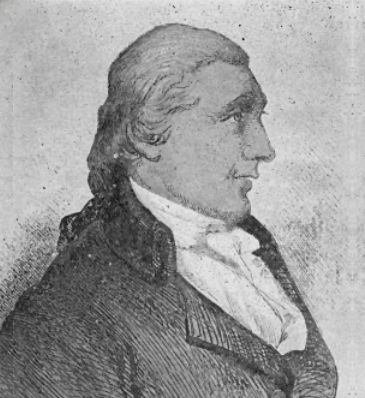The Governor’s Fire Company
• In the “Nova Scotia Calender” of 1794, an almanac published by Anthony Henry in Halifax, the Union Engine Company is listed under the name “Fire Engine Company for the Town of Halifax” (the two names are often interchanged during the following decades), but it also lists the “Governor’s Fire Company”. According to a 1793 copy examined by Patricia Lockhart Fleming and Sandra Alston, the company was listed then, which means it was in operation at the end of 1792, since the 1793 almanac was advertized as early as December 4, 1792 (Google Newspaper Archives 1792). The 1794 company roster is as follows (transcribed as is):
His Excellency the Governor John Solomon, Esquire
The Hon. Richard Bulkeley George Deblois, Esquire
The Hon. Henry Newton, Vice I. M. Freke Bulkeley, Esquire
The Hon. Alexander Brymer Dr. Clarke
The Hon. Thomas Cochran John Newton, Esquire
The Hon. Charles Morris John Slayter, Esquire
The Hon. John Haliburton Judge Brenton, (James)
The Hon. S. S. Blowers James Gautier and Clerk
John Butler Butler, Esquire Reverend Mr. Jones
Gregory Townsend, Esquire George Smith, Esquire
Mr. James Kavanagh The Chief Justice
Edward Brenton, Esquire Reverend Mr. Stanser
James Stewart, Esquire George Brinley, Esquire
Charles Nova-Scotia [?] Dr. Brown
“His Excellency the Governor” was John Wentworth, the Lieutenant-Governor of Nova Scotia from 1792 to 1808. At first glance, two names stand out: Henry and John Newton, two brothers who had previously served in the Union Fire-Club, starting April 2, 1754, and now aged 63 and 67 respectively. Also, Alexander Brymer was listed twice. “S. S. Blowers” was Sampson Salter Blowers and“Reverend Stanser” was Robert Stanser. “Reverend Jones” was probably James Jones and “Dr. Clarke” was Duncan Clark. The Chief Justice at the time was Thomas Andrew Lumisden Strange. In 1796, John Butler Butler (appears twice on purpose), George Smith and Dr. Brown were absent from the listing, and Dr. Brown left for England in 1795. The same almanac no longer listed this fire company in 1797, although it is not indicative of its existence beyond 1796.
John Wentworth
John Wentworth was born in Portsmouth, New Hampshire on August 9, 1737, to Mark Hunking Wentworth and Elizabeth Rindge. After graduating from Harvard, he travelled to London for his father's business, where he stayed for a few years. He returned to America in 1766, and was appointed governor of New Hampshire after his uncle, Benning Wentworth, stepped down. However, the House of Assembly having sided with the revolution, John fled to Boston in 1775, and landed in New York City, in 1776, where he commanded a company of loyalists. Back in England in 1778, he was sent to Nova Scotia in 1783 and became its Governor in 1792, after John Parr's death. The Governor's Fire Company was his idea. He died in Halifax on April 8, 1820 (Fingard 2003).
Alexander Brymer

Alexander Brymer was born in Scotland (perhaps Dundee) around 1745, and there is no information until 1771. Already the agent for the London-based merchants Robert Grant and William Brymer in Halifax, He was evacuated to this locality by the British Forces, from Boston, in March 1776. In 1779, he bought the estate of Thomas Saul, whose house, known as Saul's Folly, became Brymer's Palace. After the death of Charles Morris in 1781, he was sworn as a member of the Governor's Council on March 26, 1782. He held several prestigious positions in the Militia, various societies, and the Church of England. He retired to England in 1801 and died in Ramsgate on August 27, 1822 (Cahill 2003).
Thomas Cochran
Thomas Cochran was born in northern Ireland in 1733 and came to Halifax with his father and brothers (James and William), probably in 1761. He lived at 37 and 39 Hollis Street (between Bishop and Morris Streets), and with his second wife, Jane Allan, had eight children between 1777 and 1799. His public life started in 1775, when he was elected at the House of Assembly to represent the town of Liverpool, where he remained until 1788, at which time he was appointed to the Governor's Council (a.k.a. Council of Twelve). There, he served alongside Henry Newton and Isaac Deschamp. Thomas Cochran died in Halifax on August 26, 1801, at 68 years old (Eaton 1899).
Charles Morris
Charles Morris was born in Boston on June 8, 1711, to Charles Morris and Esther Rainsthorpe. As of 1834, he was a teacher at a grammar school, but in 1746, he received a commission of captain from then Governor William Shirley to raise a company for the defense of Annapolis Royal, NS, where he participated in a battle against the French and their Mi’kmaq allies at Grand Pré. Morris was one of the first Halifax settlers in 1749, and he was made Chief Surveyor of Nova Scotia the following year. He was appointed to the Council on December 30, 1755, and was subsequently sworn into the first assembly in October 1758. He was appointed senior assistant judge in 1776. He died on November 4, 1781, in Windsor, NS (Blakeley, Morris, Charles 2003).
John Haliburton
John Haliburton was born in 1725, in Scotland. He became a surgeon for the Royal Navy and settle in Newport, Rhode Island (date unknown), where he is said that have had a "splendid practice." Being a Loyalist, he was banished and left Newport in 1782 for Halifax, where he was given the reins of the Naval Medical Department, while also serving as a general practitioner. Within the five following years, he was elected president of the British North Society and was appointed to the Governor's Council (MacDonald 1903, pp. 34-37). in 1790 he had a house built, known as "The Bower," which still stands today and is located on Rogers Dr. in Halifax. He died there in 1808 and his son Brenton inherited the house (Parks Canada 1990).
Sampson Salter Blowers
Sampson Salter Blowers was born on March 10, 1741 (or 1742), in Boston, to John Blowers and Sarah Salter. A Harvard law graduate, he became a wealthy lawyer in Boston. Between 1774 and 1783, he was either in England, Boston, Newport, or New York, depending on how the American revolution was developing. He finally sailed for Halifax in September of 1783, where he practiced as a lawyer. In December 1784, he was appointed attorney general of Nova Scotia, was elected to the House of Assembly in 1785, the Council in 1788, and many other positions until his retirement in 1832. He was instrumental in the end of slavery in Nova Scotia. He died in Halifax on October 25, 1842 (Blakeley, Blowers, Sampson Salter 2003).
Gregory Townsend
Gregory Townsend was born in 1718, in Boston, to Solomon Townsend and Esther Sugars. He was one of the signatories of an address made to thank the departing governor, Mr. Hutchinson, in 1774, and another, to welcome the new governor, Mr. Gage, in 1775 (Sabine 1847). Opponents to British imperialism published the names of those signatories, known as “addressers,” causing them to be ridiculed and intimidated. It eventually forced Townsend (and many other loyalists) to be evacuated to Halifax in 1778, via the Banishment Act. He died in 1798 (The Colonial Williamsburg Foundation 2023), in Halifax, and rest at the Old Burial Grounds on the corner of Barrington Street and Spring Garden Road (The Old Burying Ground Foundation 2023).
John Solomon was born around 1740; he was a senior captain in the Royal Nova Scotia Volunteer Regiment (raised in 1775 and disbanded in 1783) who commanded Fort Sackville (Bedford) during the American Revolution (Akin 1895, p. 134). He later had a similar rank in the Royal Nova Scotia Regiment (raised in 1793 and disbanded in 1802), which was commanded by John Wentworth. He died on May 27, 1822, in Halifax, at age 82 (Murdoch 1867, pp. 210, 489).
• This company was a mixture of more experienced individuals, as almost all of them were in their fifties and sixties; extensive biographies can be found online.


